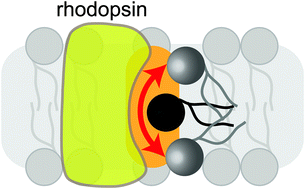Phospholipid scrambling by rhodopsin
Abstract
Rhodopsin has been intensively characterized in its role as a visual pigment and G protein-coupled receptor responsible for dim-light vision. We recently discovered that it also functions as an ATP-independent phospholipid scramblase: when reconstituted into large unilamellar vesicles, rhodopsin accelerates the normally sluggish transbilayer translocation of common phospholipids by more than 1000-fold, to rates in excess of 10 000 phospholipids transported per rhodopsin per second. Here we summarize the work leading to this discovery and speculate on the mechanism by which rhodopsin scrambles phospholipids. We also present a hypothesis that rhodopsin's scramblase activity is necessary for the function of the ABC transporter ABCA4 that is responsible for mitigating the toxic accumulation of 11-cis-retinal and bis-retinoids in the retina.

- This article is part of the themed collection: 16th International Conference on Retinal Proteins

 Please wait while we load your content...
Please wait while we load your content...